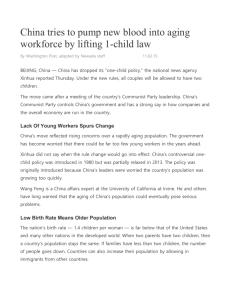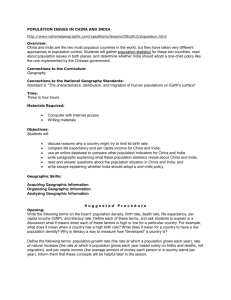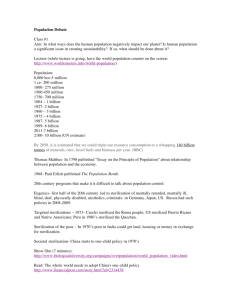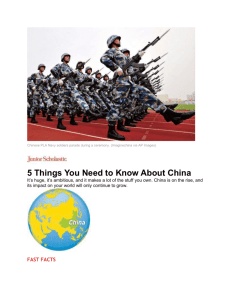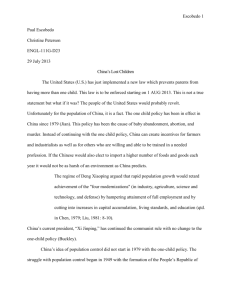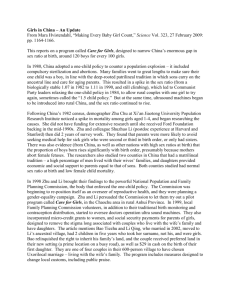Full Research Paper by Zach Lechleiter
advertisement
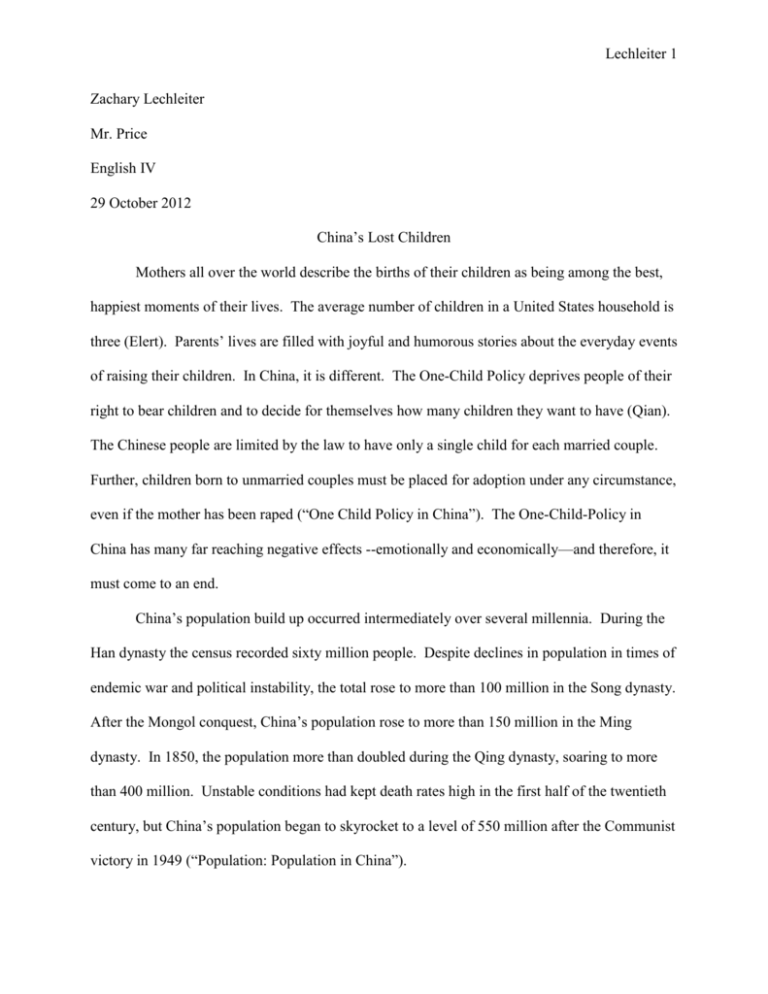
Lechleiter 1 Zachary Lechleiter Mr. Price English IV 29 October 2012 China’s Lost Children Mothers all over the world describe the births of their children as being among the best, happiest moments of their lives. The average number of children in a United States household is three (Elert). Parents’ lives are filled with joyful and humorous stories about the everyday events of raising their children. In China, it is different. The One-Child Policy deprives people of their right to bear children and to decide for themselves how many children they want to have (Qian). The Chinese people are limited by the law to have only a single child for each married couple. Further, children born to unmarried couples must be placed for adoption under any circumstance, even if the mother has been raped (“One Child Policy in China”). The One-Child-Policy in China has many far reaching negative effects --emotionally and economically—and therefore, it must come to an end. China’s population build up occurred intermediately over several millennia. During the Han dynasty the census recorded sixty million people. Despite declines in population in times of endemic war and political instability, the total rose to more than 100 million in the Song dynasty. After the Mongol conquest, China’s population rose to more than 150 million in the Ming dynasty. In 1850, the population more than doubled during the Qing dynasty, soaring to more than 400 million. Unstable conditions had kept death rates high in the first half of the twentieth century, but China’s population began to skyrocket to a level of 550 million after the Communist victory in 1949 (“Population: Population in China”). Lechleiter 2 At first leaders opposed population controls, based on the assumption that a larger population was a source of national strength. They came to realize a need for late marriage, family planning techniques, and finally, the One-Child Policy that went into effect in 1980. China’s leaders permitted families to have only one child each. They envisaged stopping the growth of China’s population at one and two-tenths billion before the end of the century. They succeeded in bringing birth rates down sharply (“Population: Population in China”). By early 1980, policy demanded that ninety-five percent of urban women and ninety percent of rural women be allowed only one child (Meulenberg). In the late 1990s, thirty-five and four-tenths percent of the Chinese population lived in regions where there was a strict One-Child Policy (Davin). At the start of the nineteenth century, China obtained over one half of the world’s population. After the input of the One-Child Policy, it dropped to having one fourth of the world’s total population by the later part of the twentieth century (“Population: Population in China”). After only being in place for thirty-two years, the One-Child Policy has helped to avoid births adding up to the total population of China in 1850 (Wong). China’s population growth has dropped from two percent to one and a half percent since its implementation in 1980 (“One Child Policy in China”). The Policy is said to consider the interaction between science, technology, economics, and society. High population growth strains societal resources in education, employment, and medical care, as well as other areas. The Policy is also said to be put in place in order to avoid genetic and other birth defects. Without the institution of the One-Child Policy, resources would be wasted on supporting children potentially slowing the pace of social development (“Population Policy in China”). Lechleiter 3 China’s One-Child Policy has been the source of much political and social controversy since it was implemented in 1980 (“One Child Policy in China”). In recent years, the stringent population controls have attracted the most attention (“Population: Population in China”). Critics say that enforcement of the policy leads to wide spread abuses, including forced abortions, because many local governments reward or penalize officials based on how well they keep down the population (Wong). The One-Child Policy advocates a “One couple, One child policy.” It encourages late marriages and late, fewer, but healthier babies (Qian). The fine for having extra children is known as the “Social Maintenance Fee.” The amount of one’s fine varies from place to place, as well as by income. The rich can shell out millions. A husband and wife in Shanghai will each pay $110,000 yuan ($17,300), three times the city’s average annual post tax income, for a second child (“The Brutal Truth; The One Child Policy”). Among upper class families, two or three children have become a status symbol, a sign of wealth and prosperity (“One Child Policy in China”). There are accounts of heavy sanctions for noncompliance, including the doubling of health insurance and long-term income deductions as well as forced abortions and sterilizations (Meulenberg). In the case of the young family, Mr. Yang and his wife refused to pay a fine for their second daughter. The transgression cost Mr. Yang his job as a law professor. In April a sum of 240,300 yuan was taken from his wife’s account. Failure to pay means the second “black” child cannot obtain a household registration document, or hukou, which brings with it basic rights such as education (“The Brutal Truth; The One Child Policy”). By 1984, some exceptions were being made (“Population: Population in China”). Officials say that the Chinese family planning policy is tailored to meet the practical living needs of people in different regions of the country (“Population Policy in China”). If a couple simply Lechleiter 4 “has the right connections” they may be eligible to have a second child. The same holds true if one parent works in the fishing industry and is going to sea for a minimum of five years (“The Brutal Truth; The One Child policy”). If both parents are only children, they may be permitted to have two of their own children. Chinese national minorities have consistently been subject to less restrictive birth planning. Divorcees who remarry also may be permitted to have a second child (Meulenberg). Rural couples who have a need for more children, if spaced properly, may have a second child (Qian). Others circumvent the policy by “studying” abroad with spouses and conceiving and delivering while outside China, coming back with two or more children without coercion or harassment (“One Child Policy in China”). In 2007, a family planning official estimated that the One-Child Policy applied to less than forty percent of the population (“The Brutal Truth; The One Child Policy”). It is commonly accepted that preferential treatment in public services such as education, health, and housing is normally given to one-child families. Parents abiding by the One-Child Policy often obtain monthly bonuses, usually paid until the child reaches the age of 14 (Meulenberg). Women benefit from the One-Child Policy, which gives those greater maternity rights, more earning power, and better education opportunities. Parents who choose to limit their families to one child receive a “one-child certificate” and are frequently given preferred jobs, housing, and maternity leaves, while those who have more than one child are charged with higher tuition for school for the second child, higher day care rates, higher tax penalties, and in some cases discriminated against by local government officials (“One Child Policy in China”). The Chinese Academy of Social Sciences defined “deprived parents” as those who lose their only offspring at or after the age of forty-nine--the age doctors consider to be too old to have another child. When these one-child families lose their grown-up children, however, the Lechleiter 5 pain is unbearable. Of the 295 people who died between birth and thirty years old in 2007 and 2008, sixty-six percent died between the ages of eighteen and thirty, when their parents were too old to have another child. Out of every 10,000 births, 360 died before the age of ten and 463 died before the age of twenty-five. Statistically, that means ten and nine-hundredths million out of China’s 218 million members of the one-child generation end up dying before reaching the age of twenty-five (“Xinhua Insight”). The pain of losing one’s only child, Zhou Daxin wrote, was far more than that of a broken heart; “it is an unbearable, desperate feeling that is beyond words and tears you apart from the inside,” she said. She spent the last eight years of her life troubled by grief, poverty, and disease. She could only pour her feelings out to a few people she met online who were in the same boat and could share her sorrow (“The Brutal Truth; The One Child Policy”). Sociologist Yi Fuxian estimates that as many as ten million Chinese families have lost their only offspring (“Xinhua Insight”). The traditional belief in China is that families should have as many children as they can, as they are needed to care for their parents when they reach old age (“Xinhua Insight”). Tradition in China dictates that the son must support his parents and his grandparents, leaving one man to support up to six elders. Two children in such a family would help to alleviate the pressure (“One Child Policy in China”). Traditional desire for male children forces parents into abandoning or aborting their female offspring (Qian). The 2000 census put the national sex ratio at 117 boys to 100 girls. The sex ratio in Shanghai stands at 105 boys to 100 girls. According to The Guardian newspaper, China may have as many as forty million single men by 2020 (Muelenberg). As China’s population rises, so does the male to female sex ratio. This means that seventeen out of every 117 males were not able to legally reproduce in China, as they were not bound in marriage. Lechleiter 6 Economists and business executives have expressed anxiety about the impact of a slowing population growth rate on the economy. An aging population is resulting in a labor shortage, a less innovative and less energetic economy, and a more difficult path to industrial upgrading (Wong). A major concern is that as the birth rate drops, a smaller pool of young workers will be left to support a large population of retirees (Muelenberg). Economists say that with China’s aging population and dwindling pool of young, cheap labor will be a significant factor in slowing the nation’s economic growth rate. The working population—people between the ages of twenty and sixty—would drop to 696 million from 817 million today. Li Jianxian, a demographer at Perking University, has estimated that by 2040, the number of Chinese older than sixty would be 411 million, up from 171 million today (Wong). Evidence suggests that China’s only children demonstrate superior cognitive skills in the earlier years when compared to their peers with siblings. This is due to intensive parental care, greater intellectual stimulation, being exposed to more interaction with adults, and being faced with greater psychological pressure to succeed than their older peers (Lam). China’s orphanages are filled with children of all ages abandoned under the One-Child Policy. Over ninety-five percent of all children adopted from China are female. Orphaned children are tied to chairs, left to dehydrate or starve, given little if any medical care, and in some instances actively murdered (“One Child Policy in China”). Due to the One-Child Policy, contraception is widely available in China, and official statistics place contraception use at approximately eighty-three percent, more than double the consistent rate of contraception use in the U.S. by women of childbearing age. More than thirtyeight percent of all Chinese women have been sterilized, and nearly eight percent of Chinese men have been sterilized as well (“One Child Policy in China”). The wide use of abortions in Lechleiter 7 China is greatly accredited to modern ultrasound technology, which enables couples to abort female fetuses in hopes that the next pregnancy will be a son (Meulenberg). In 1983, fourteen million women had abortions organized by family planning committees. Many of them were coerced. In 2009, there were six million. The number has declined in recent years as local officials have more incentives to impose fines on extra births rather than prevent them altogether (“The Brutal Truth; The One Child Policy”). Pan Chunyan was grabbed from her grocery store when she was almost eight months pregnant with her third child. Men working for a local official locked her up with two other women, and four days later brought her to a hospital and forced her to put her thumb print on a document saying she agreed to an abortion. A nurse injected her with a drug. “After I got the shot, all the thugs disappeared,” Ms. Pan, 31, said in a telephone interview from her home in the southeastern province of Fujian. “My family was with me again. I cried and hoped the baby would survive.” Hours of labor later, the baby was born dead on April eighth, “black and blue all over,” Ms. Pan said. Ms. Pan’s husband, Wu Liangjle, said the couple gave Mr. Ma, the head of the township’s family planning commission, $8,700 as he demanded, but Mr. Ma still ordered the abortion (Wong). Scholars were outraged by the story of Feng Jianmei, told in The Economist, a national magazine. Jianmei was a victim of a forced late-term abortion in early June whose case became widely known after photographs of her dead seven month old fetus were posted on the internet (Wong). In the photographs, the young mother lies on a clinic bed, her hair obscuring her face. She appears as inert as the baby lying beside her. Micro blogs flashed the pictures to millions of people across the country. Chinese citizens expressed their outrage online. It is not just the treatment of Ms. Feng that they deplore; it is the One-Child Policy itself. For Ms. Feng, living in Lechleiter 8 a rural area, the fine was 40,000 yuan. She was given the option to pay and keep the baby but could not afford it. Her husband, Deng Ji, earned 4,000 yuan a month at the local hydroelectric power station. At first a dozen officials tried to force Ms. Feng into a car. She fled to an aunt’s house, but they broke through the gate, so she escaped to the mountains nearby, where she hid under a bed in a friend’s house. “They laughed when they found her,” says Mr. Deng. After an injection to her belly, Ms. Feng gave birth to the dead baby thirty hours later. “I had no money to pay the fine,” said her husband. “But does that mean we should suffer the grief of losing a child?” (“The Brutal Truth; the One Child Policy”). Chinese policy makers argue concerns for the common good should outweigh individual freedoms (Qian). It is for cruel cases like these that the One-Child Policy in China should be ended. Methods like the ending of free schooling in China – that may prove to be an even better tool for restricting population growth than any family planning policy – should be used instead. The downfall of economics, traditions, an even sex ratio, and personal emotion is sure to come. What the government thinks is the best for the common good should not outweigh individual freedoms. Let tradition rule and have families choose the number of children they birth. Stop the unjust punishments. Stop the policy. Lechleiter 9 Works Cited “One-Child Policy in China.” Family in Society: Essential Primary Sources. Ed. K. Lee Lerner, Brenda Wilmoth Lerner, and Adrienne Wilmoth Lerner. Detroit: Gale, 2006. 310-315. Gale World History in Context. Web. 8 Oct. 2012. “Population: Population in China.” Encyclopedia of Asian History. Charles Scribner’s Sons, 1988. Gale World History In Context. Web. 8 Oct. 2012. “The Brutal Truth; The One-Child Policy.” The Economist [US] 23 June 2012: 49(US). Gale World History in Context. Web. 8 Oct. 2012. “Xinhua Insight: One-Child Policy Leaves Bereaved Parents with Broken Hearts.” Xinhua News Agency 14 Sept. Gale World History in Context. Web. 8 Oct. 2012. Davin, Delia. “Cultivating Global Citizens: Population in the Rise of China.” The China Journal 66 (2011): 193+. Gale World History in Context. Web. 8 Oct. 2012. Elert, Glenn. "Number of People in a Family." hypertextbook. StaceyJohnson, n.d. Web. 23 Oct. 2012. <http://hypertextbook.com/facts/2006/StaceyJohnson.shtml>. Lam, Y. L. Jack. “Single-Child Phenomenon—China.” Encyclopedia of Modern Asia. Ed. Karen Christensen and David Levinson. Vol. 5. New York: Charles Scribner’s Sons, 2002. 223225. Gale World History in Context. Web. 8 Oct. 2012. Meulenberg, Claudia. “[begin strikethrough]Definitely[end strikethrough] Probably One: A Generation Comes of Age Under China’s One-Child Policy.” World Watch Sept.-Oct. 2004: 31+. Gale World History in Context. Web 8 Oct. 2012. Qian, Wang, and Qian Qian. “Population Policy in China.” Encyclopedia of Science, Technology, and Ethics. Ed. Carl Mitcham. Vol. 3. Detroit: Macmillan Reference USA, 2005. 1456-1458. Gale world History in Context. Web. 27 Sep. 2012. Lechleiter 10 Wong, Edward. “Pressure Grows in China to End One-Child Law.” New York Times 23 July 2012: A1(L). Gale World History in Context. Web. 8 Oct. 2012.
